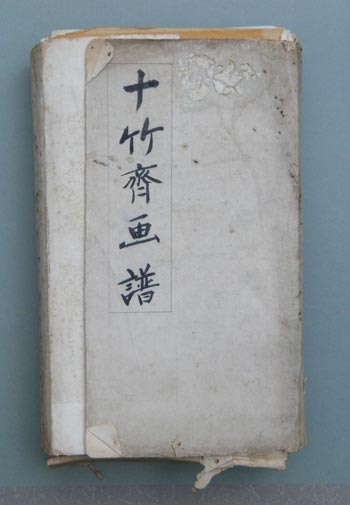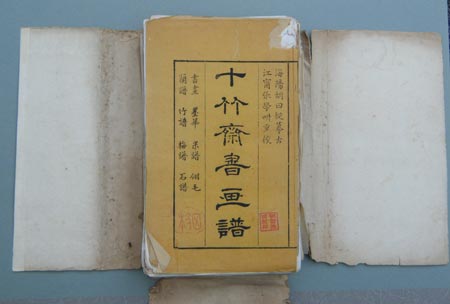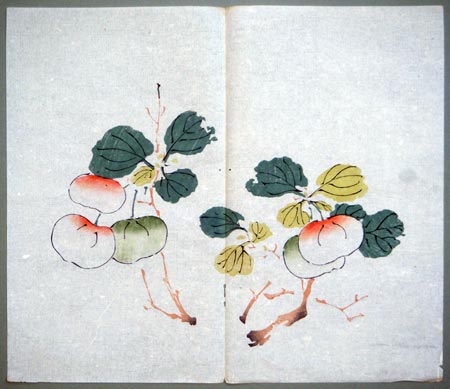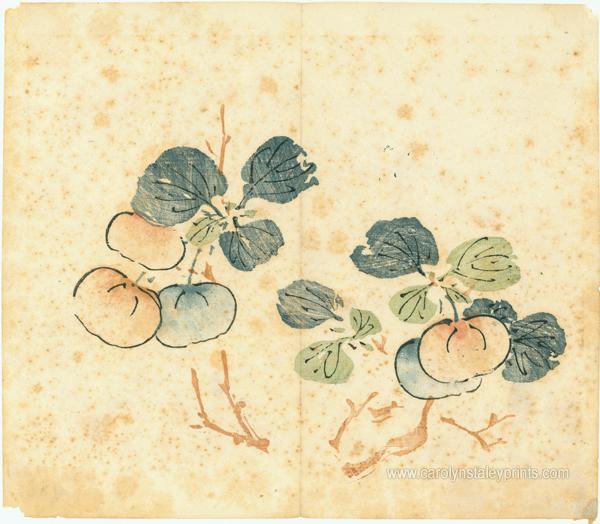Posted by Dave Bull at 2:25 AM, September 9, 2011 [Permalink]
Time to have a look at the design for #16, and where it came from. And we have to go back quite a long way ... nearly 400 years. For this entry in the 'Mystique of the Japanese Print' series, we're going to 'step outside' of the Japanese tradition for a moment, and have a look at a historical precedent ...
Before we begin though, let's slip back around ten years or so, to a day one summer when my daughter Fumi was here on a visit from Canada. At that time (this was before she entered university), she was running a little business, taking advantage of her bilingual abilities and her frequent travel back and forth across the Pacific during her school holidays.
Each time she was here, the two of us would spend most of a day down in the Kanda book district, going through bins in the shops that carried woodblock prints and related material. We would come home with quite a large stack of prints and books, and would spend the next few days cataloguing and pricing it all. She then took the prints back to Canada, and over the next few months, would then put it all on the market, either on eBay, or through the little shop she and I built on the internet, at Hangaclub.com.
Because she had good help making the selections :-) she gradually gained a reputation for having good quality products at reasonable prices, and developed quite a good 'following'. Her little business flourished, to the extent that she was able to purchase her first car (a Miata sports car) with the proceeds. This all came to an end when she entered university, as she felt that she would not be able to concentrate properly on her studies while also running a business, so she closed the shop. And four years later, when she graduated, she opened a different business, one that was more in line with her own interests, which don't particularly include wood block prints!
Anyway, to get back to our Mystique print, it was while the two of us were in a particularly dusty and messy shop one day that we came across an interesting item - a cardboard box full of what looked to be random scraps of prints and calligraphy. As I turned over some of the sheets I had one of those heart-stopping moments that we so long for when visiting such dusty places. I knew right away what I was looking at - a stack of loose sheets from the famous 'Ten Bamboo Studio' collection, something I had only ever seen in illustrations, never in real life.
I knew enough to understand that these scraps weren't from the 400-year-old original Chinese edition, but were almost certainly from a mid-19th century Japanese printing, so this wasn't a 'million dollar' find, but it was rare enough to get me plenty excited! Fumi couldn't understand my enthusiasm - as the box really just looked like a random pile of torn scraps - and when she saw that I actually intended to buy the box and its contents (for around 20,000 yen), wasn't too pleased with me.
When we got home though, and I showed her some references on the book, explaining how the volumes were structured: one on bamboo, one on stones, one for birds, etc., she got interested in solving the 'puzzle'. She shut the cat out of the room, spread the hundreds and hundreds of sheets all over the floor, and set to work to reconstruct the book. She did a wonderful job, mostly by matching up worm holes to figure out which pages should be adjacent, and after many hours of work, presented me with the reassembled set of volumes.


And ... to finally get to the point here ... this is one sheet, from the 'Fruits' volume:

This is a mid-19th century Japanese publisher's re-creation, based on (almost certainly) an 18th or 19th century Chinese copy, which itself was probably based on an earlier copy. (The original is exceedingly rare, but quite a number of reproductions were made, most of which were not particularly 'faithful' to the earliest work.) Here's an image I found on the 'net of what seems to be a Chinese reproduction:

And here's a book illustration of a sheet in the British Museum, which the curators 'think' is perhaps from the original:

If so, then it is either an incomplete sheet, or the colours have faded into obscurity ...
None of these are from the same block set, as there are many clear differences in the carved lines and shapes.
So at this point, with nearly 400 years having gone by (the original dates from around 1640), I think I have a pretty free hand to take this on. For my carving model, I'll use the British Museum sheet, as it is clearly of the best quality, line-wise. For the colours, I will have to use my imagination, with some hints taken from these editions. It won't take too long to carve, but printing ... will be another story!
